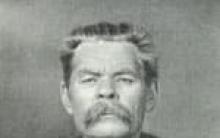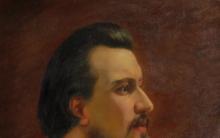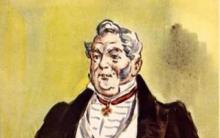"Olesya"
In 1897, Kuprin served as an estate manager in the Ro-Vienna district of the Volyn province. The amazing nature of the Polesie region and the dramatic destinies of its inhabitants were revealed to the writer. On the basis of what he saw, he created a cycle of "Polesie Tales", which included "Olesya" - a story about nature and love.
The story begins with a description of a picturesque corner where the hero spent six months. He talks about the uncommunicativeness of the Polissya peasants, about traces of Polish rule, about customs and superstitions. In the world on the threshold of the 20th century with its rapid development of natural sciences, technology and social transformations, traditional ideas about good and evil, about love and hatred, about enemies and friends have been preserved. Sometimes it seems to the hero that he is in some kind of reserved world, in which time has stopped. Here people believe not only in God, but also in devils, devil, water. The space is divided into its own - clean, Christian - and pagan: evil forces that can bring grief and illness live in it. All these sketches are necessary in order to introduce the reader to the atmosphere of Polissya places and explain the reason for the negative attitude of the peasants to the hero's novel with the "witch".
Nature, with its beauty and charm, with its enlightening effect on the human soul, determines the whole flavor of the story. The winter forest landscape contributes to a special state of mind, the solemn silence emphasizes the detachment from the world. The hero meets Olesya in winter and spring, when the renewed nature and the revived forest awaken feelings in the souls of two people. In the beauty of Olesya, in the proud power emanating from her, the strength and charm of the world around her are embodied. A beautiful heroine is inseparable from the greatness of the pristine nature of this land, whose name seems to echo the words "forest" and "Polesie".
Kuprin sketches a portrait in which earthly and sublime beginnings are fancifully combined: “My stranger, a tall brunette of about twenty or twenty-five, kept herself light and slender. A spacious white shirt loosely and beautifully wrapped around her young, healthy breasts. The original beauty of her face, once seeing it, could not be forgotten, but it was difficult, even getting used to it, to describe it. His charm lay in those large, shiny, dark eyes, to which thin, broken eyebrows in the middle gave an imperceptible shade of guile, imperiousness and naivety; in the dark-pink rut of skin, in the willful bend of the lips, of which the lower one, somewhat fuller, protruded forward with a resolute and capricious look.
Kuprin managed to vividly embody the ideal of a natural person, free, original and whole, living in harmony and harmony with nature, “who grew up in the open spaces of the old pine forest as harmoniously and as powerful as young Christmas trees grow”, which is close to Tolstoy's traditions.
The heroine's chosen one, Ivan Timofeevich, is humane and kind in his own way, educated and intelligent, endowed with a "lazy" heart. Fortune-telling to her betrothed, Olesya says: “Your kindness is not good, not cordial. You are not master of your word. You like to take the upper hand over people, and although you yourself do not want to, you obey. "
And such different people fell in love with each other: “A month has risen, and its radiance, strangely motley and mysteriously blossomed the forest ...<.„>And we walked, embracing, among this smiling living legend, without a single word, suppressed by our happiness and the terrible silence of the forest. " The magnificent nature with its play of colors echoes the heroes, as if spellbound by the beauty of youth. But the forest tale ends tragically. And not only because cruelty and meanness of the surrounding world bursts into the light world of Olesya. The writer poses the question on a larger scale: could this girl, a child of nature, free from all conventions, live in a different environment? The theme of shared love is replaced in the story by another, constantly resounding in the work of Kuprin - the theme of unattainable happiness.
"Olesya" Kuprin A.I.
"Olesya" is one of the first major works of the author and, in his own words, one of the most beloved. It is logical to start the analysis of the story from the background. In 1897, Alexander Kuprin served as an estate manager in the Rivne district of the Volyn province. The young man was impressed by the beauty of Polissya and the difficult fates of the inhabitants of this region. On the basis of what he saw, a cycle of "Polesie stories" was written, the decoration of which was the story "Olesya".
Despite the fact that the work was created by a young author, it attracts literary critics with its complex problems, the depth of the characters of the main characters, and amazing landscape sketches. The composition of the story "Olesya" is a retrospective. The narration comes from the person of the narrator, who recalls the events of days gone by.
The intellectual Ivan Timofeevich comes from a big city to stay in the remote village of Perebrod in Volyn. This reserved land seems very strange to him. On the threshold of the twentieth century, technical and natural sciences are rapidly developing, and enormous social transformations are taking place in the world. And here, it seems that time has stopped. And people in this land believe not only in God, but also in goblin, devils, water and other otherworldly characters. Christian traditions are closely intertwined in Polissya with pagan ones. This is the first conflict in the story: civilization and wildlife live according to completely different laws.
Another conflict follows from their confrontation: people brought up in such different conditions cannot be together. Therefore, Ivan Timofeevich, who personifies the world of civilization and the witch Olesya, who lives according to the laws of the wild, are doomed to part.
The closeness of Ivan and Olesya is the culmination of the story. Despite the mutual sincerity of feelings, the characters' understanding of love and duty differ significantly. Olesya in a difficult situation behaves much more responsible. She is not afraid of further events, it is only important that she is loved. Ivan Timofeevich, on the other hand, is weak and indecisive. In principle, he is ready to marry Olesya and take her with him to the city, but he really has no idea how this is possible. Ivan in love is not capable of an act, since he is used to going with the flow in life.
But one in the field is not a warrior. Therefore, even the sacrifice of a young witch, when she decides to go to church for the sake of her chosen one, does not save the situation. A beautiful but short tale of mutual love ends tragically. Olesya and her mother are forced to flee their home, fleeing the wrath of superstitious peasants. Only a thread of red coral remains in her memory.
The story of the tragic love of an intellectual and a witch inspired the film adaptation of the work of the Soviet director Boris Ivchenko. The main roles in his film "Olesya" (1971) were played by Gennady Voropaev and Lyudmila Chursina. And fifteen years earlier, the French director Andre Michel based on Kuprin's story made the film "The Witch" with Marina Vlady.
Alexander Ivanovich Kuprin often painted in his works an ideal image of a “natural” person, one who is not subject to the pernicious influence of light, whose soul is pure, free, who is close to nature, lives in it, lives with it in a single impulse. A striking example of the disclosure of the theme of "natural" man is the story "Olesya".
The story described in the story did not appear by chance. Once A.I. Kuprin visited the landowner Ivan Timofeevich Poroshin in Polesie, who told the writer the mysterious story of his relationship with a certain witch. It was this story, enriched with fiction, that formed the basis of Kuprin's work.
The first publication of the story took place in the magazine "Kievlyanin" in 1898, the work bore the subtitle "From Memories of Volyn", which emphasized the real basis of the events taking place in the story.
Genre and direction
Alexander Ivanovich worked in the late 19th - early 20th centuries, when the controversy between two directions gradually began to flare up: realism and modernism, which was just beginning to declare itself. Kuprin belongs to the realistic tradition in Russian literature, so the story "Olesya" can be safely attributed to realistic works.
In terms of genre, the work is a story, since it is dominated by a chronicle plot that reproduces the natural course of life. The reader lives through all the events, day after day, following the main character Ivan Timofeevich.
The essence
The action takes place in the small village of Perebrod, Volyn province, on the outskirts of Polesie. The young master-writer is bored, but one day fate takes him to the swamp to the house of the local witch Manuilikha, where he meets the beautiful Olesya. A feeling of love flares up between Ivan and Olesya, but the young sorceress sees that her death awaits if she connects her fate with an unexpected guest.
But love is stronger than prejudice and fear, Olesya wants to deceive fate. For the sake of Ivan Timofeevich, a young witch goes to church, although due to her occupation and origin, she is not allowed to enter there. She makes it clear to the hero that she will commit this brave act, which may entail irreparable consequences, but Ivan does not understand this and does not have time to save Olesya from the angry crowd. The heroine is severely beaten. She sends a curse to the village in revenge, and on the same night a terrible thunderstorm occurs. Knowing the power of human anger, Manuilikha and his pupil hurriedly leave the house in the swamp. When a young man comes to this dwelling in the morning, he finds only red beads, as a symbol of their short but true love with Olesya.
The main characters and their characteristics
The main characters of the story are the master-writer Ivan Timofeevich and the forest sorceress Olesya. Completely different, they got along, but could not be happy together.
- Characteristics of Ivan Timofeevich... This person is kind, sensitive. He was able to discern in Olesya a living, natural beginning, because he himself had not yet been completely killed by a secular society. The fact that he left the noisy cities for the village speaks volumes. The heroine for him is not just a beautiful girl, she is a mystery to him. This strange healer believes in conspiracies, guesses, communicates with spirits - she is a witch. And all this attracts the hero. He wants to see, learn something new, real, not covered with falseness and far-fetched etiquette. But at the same time, Ivan himself is still at the mercy of the world, he thinks about marrying Olesya, but he is embarrassed by how she, a savage, appears in the halls of the capital.
- Olesya is the ideal of a "natural" person. She was born and lived in the forest, nature was her educator. Olesya's world is a world of harmony with the surrounding world. In addition, she is in harmony with her inner world. It is possible to note the following qualities of the main character: she is wayward, straightforward, sincere, she does not know how to pretend and pretend. The young sorceress is smart, kind, one has only to remember the first meeting of the reader with her, because she was tenderly carrying chicks in the hem. One of the main features of Olesya can be called insubordination, which she inherited from Manuilikha. They both seem to be against the whole world: they live aloof in their own swamp, do not profess an official religion. Even knowing that you cannot escape fate, the young sorceress still tries, flatters herself with the hope that everything will work out with Ivan. She is original and unshakable, despite the fact that love is still alive, she leaves, abandons everything, without looking back. The image and characteristics of Olesya are available.
Themes
- The main theme of the story- Olesya's love, her readiness for self-sacrifice - is the center of the work. Ivan Timofeevich was fortunate enough to meet with a real feeling.
- Another important semantic branch is the theme of the opposition of the ordinary world and the world of people of nature. Residents of villages, capitals, Ivan Timofeevich himself are representatives of everyday thinking, permeated with prejudices, conventions, and clichés. The worldview of Olesya and Manuilikha is freedom, open feelings. In connection with these two heroes, the theme of nature appears. The environment is a cradle that raised the main character, an irreplaceable assistant, thanks to which Manuilikha and Olesya live far from people and civilization without need, nature gives them everything they need for life. This topic is disclosed most fully in this one.
- The role of landscape the story is huge. It is a reflection of the feelings of the characters, their relationships. So, at the origin of the novel, we see a sunny spring, and at the end, the breakup is accompanied by a strong thunderstorm. We wrote more about this in this.
Problems
The subject matter of the story is varied. First, the writer sharply depicts the conflict between society and those who do not fit into it. So, once they brutally expelled Manuilikha from the village, beat Olesya herself, although both sorceresses did not show any aggression towards the villagers. Society is not ready to accept those who differ from them in any way, who do not try to pretend, because they want to live by their own rules, and not by the template of the majority.
The problem of her relationship to Olesya is most clearly manifested in the scene of her going to church. For the Russian Orthodox people of the village, it was a real insult that the one who serves the evil spirits, in their opinion, came to the temple of Christ. At the church, where people ask for God's mercy, they themselves administered a cruel and merciless judgment. Perhaps the writer wanted, on the basis of this antithesis, to show that the idea of righteousness, goodness, and just was distorted in society.
Meaning
The idea of the story is that people who grew up far from civilization turn out to be much nobler, more delicate, polite and kinder than the "civilized" society itself. The author hints that herd life dulls the personality and erases its individuality. The crowd is submissive and promiscuous, and is often taken over by the worst of the crowd, not the best. Primitive instincts or acquired stereotypes, such as misinterpreted morality, direct the collective towards degradation. Thus, the inhabitants of the village show themselves to be more savages than two sorceresses living in a swamp.
Kuprin's main idea is that people must once again turn to nature, must learn to live in harmony with the world and with themselves, so that their cold hearts melt. Olesya tried to open the world of real feelings to Ivan Timofeevich. He could not understand this in time, but the mysterious witch and her red beads will remain in his heart forever.
Output
Alexander Ivanovich Kuprin in his story "Olesya" tried to create the ideal of man, to show the problems of the artificial world, to open people's eyes to the guided and immoral society that surrounds them.
The life of the wayward, unshakable Olesya was to some extent destroyed by the touch of the secular world in the person of Ivan Timofeevich to her. The writer wanted to show that we ourselves are destroying the beauty that fate gives us, simply because we are blind, blind in soul.
Criticism
The story "Olesya" is one of the most famous works of A.I. Kuprin. The strength and talent of the story was appreciated by the writer's contemporaries.
K. Barkhin called the work a "forest symphony", noting the smoothness and beauty of the language of the work.
Maxim Gorky noted the youth, the spontaneity of the story.
Thus, the story "Olesya" occupies an important place, as in the work of A.I. Kuprin, and in the history of Russian classical literature.
Interesting? Keep it on your wall!1) The problem of tolerance / cruelty.
Local peasants consider Olesya and her grandmother Manuilikha to be witches, so the villagers are ready to blame them for all their troubles. Once human hatred forced them to leave their homes, and now Olesya's only desire is to be left alone.
2) The problem of loneliness.
Olesya and her grandmother Manuilikha are not accepted by the locals into their ranks, considering them to be witches. Because of this, poor women are forced to live in a hut, which is located in the forest, away from the village and its inhabitants.
3) The problem of tragic love.
Ivan Timofeevich, indecisive and cautious, cannot go against the rules of his environment. He does not know how to take care of others. One day he puts Olesya in front of a choice between himself and her grandmother. This leads to the need for the girl and her relative to leave the village, because they are in danger from the local residents.
4) The problem of the influence of the beauty of nature on a person.
Olesya grew up in harmony with nature. Thanks to this, various talents are developed in her, for example, healing. She possesses not only physical but also spiritual beauty. Living in solitude with nature endowed the girl with curiosity. The city and civilization are the embodiment of human vices for Olesya.
5) The problem of education.
Woodsman Yarmola is good at housekeeping, but he is not trained to read and write. According to him, there are no literate people in the village. Yarmola asks Ivan Timofeevich to teach him how to write in order to be able to sign for the whole village if necessary.
Updated: 2018-03-30
Attention!
Thank you for the attention.
If you notice an error or typo, select the text and press Ctrl + Enter.
Thus, you will be of invaluable benefit to the project and other readers.
Useful material on the topic
The theme "Olesya" by Kuprin is an immortal theme of cordial relationships and burning passions. She is brightly and sincerely shown for her time in Kuprin's touching story, written in the very center of nature in Polesie.
The clash of lovers from different social groups exacerbates their relationship with a shade of self-sacrifice, their own life principles and their evaluations by other people.
Analysis of "Olesya" Kuprin
A mysterious girl, who was born surrounded by nature, has absorbed all the genuine and immaculate traits of a meek and simple character, she collides with a completely different person - Ivan Timofeevich, who is considered an effective representative of society in the city.
The quivering relationship that began between them presupposes a life together, where, as usual, a woman is obliged to adapt to the new surrounding atmosphere of life.
Olesya, accustomed to her fabulous life in a calm, beloved forest with Manuilikha, takes the changes in her life experience very hard and painfully, in fact giving up her own principles in order to be with her lover.
Sensing the fragility of her relationship with Ivan, she makes perfect self-sacrifice in the ruthless city, poisoned by heartlessness and misunderstanding. Until then, however, the relationship of the young is strong.

Yarmola describes to Ivan the image of Olesya and her aunt, proves to him the uniqueness of the fact that magicians and sorceresses live in the world, prompts him to be extremely carried away by the riddle of a simple girl.
Features of the work
Very colorfully and naturally, the writer draws the habitat of a magical girl, which cannot be overlooked when analyzing Kuprin's "Olesya", because the landscape of Polesie emphasizes the exclusivity of the people living in it.
It is often said that the stories of Kuprin's stories were written by life itself.
Obviously, the majority of the younger generation will at first find it difficult to understand the meaning of the story and what the author wants to convey, but later, after reading some chapters, they will be able to become interested in this work, discovering its depth.
The main problems of "Olesya" Kuprin
This is an excellent writer. He managed to express in his own work the most difficult, high and gentle human emotions. Love is a wonderful feeling that a person experiences, like a touchstone. Not many people have the ability to truly and with an open heart. This is the fate of a strong-willed personality. These are the people the author is interested in. Correct people, existing in harmony with themselves and the world around them, are a model for him, in fact, such a girl is created in the story "Olesya" by Kuprin, whose analysis we analyze.

An ordinary girl lives in the vicinity of nature. She listens to sounds and rustles, deciphers the screams of different creatures, is very pleased with her life and independence. Olesya is independent. She has enough of the sphere of communication that she has. She knows and understands the forest surrounding from all sides, the girl perfectly feels the nature.
But a meeting with the human world promises her, unfortunately, continuous troubles and grief. The townspeople think that Olesya and her grandmother are witches. They are ready to dump all mortal sins on these unfortunate women. One fine day, the anger of people has already driven them from a warm place, and from now on the heroine has only one desire: to get rid of them.
However, the soulless human world knows no mercy. This is where the key problems of "Olesya" Kuprin lie. She is especially intelligent and smart. The girl is well aware of what a meeting with a city dweller, "Ivan the panic", portends for her. It is not suitable for the world of enmity and jealousy, profit and falsehood.
The girl's dissimilarity, her grace and originality instill anger, fear, and panic in people. The townspeople are ready to blame Olesya and the grandmother for absolutely all hardships and misfortunes. Their blind fear of the "witches" they called them is kindled with violence without any consequences. Analysis of "Olesya" Kuprin makes us understand that the appearance of a girl in the temple is not a challenge to the inhabitants, but a desire to understand the human world in which her beloved lives.
The main characters of Kuprin's "Olesya" are Ivan and Olesya. Secondary - Yarmola, Manuilikha and others, to a lesser extent important.
Olesya
A young girl, slim, tall and charming. She was raised by her grandmother. However, despite the fact that she is illiterate, she has a natural mind of centuries, a fundamental knowledge of the human essence and curiosity.
Ivan
A young writer, looking for a muse, came from town to village on official business. He is intelligent and smart. The village is distracted by hunting and meeting the villagers. Regardless of his own background, he behaves normally and without arrogance. "Panych" is a good-natured and sensitive guy, noble and weak-willed.











Characteristics of Grinev in Pushkin's "The Captain's Daughter"
Characteristics of the main characters of the work War and Peace, Tolstoy
The first and second editions of "The Inspector
"War and Peace": characteristics of the main characters
Speech characteristics of the heroes of the play N